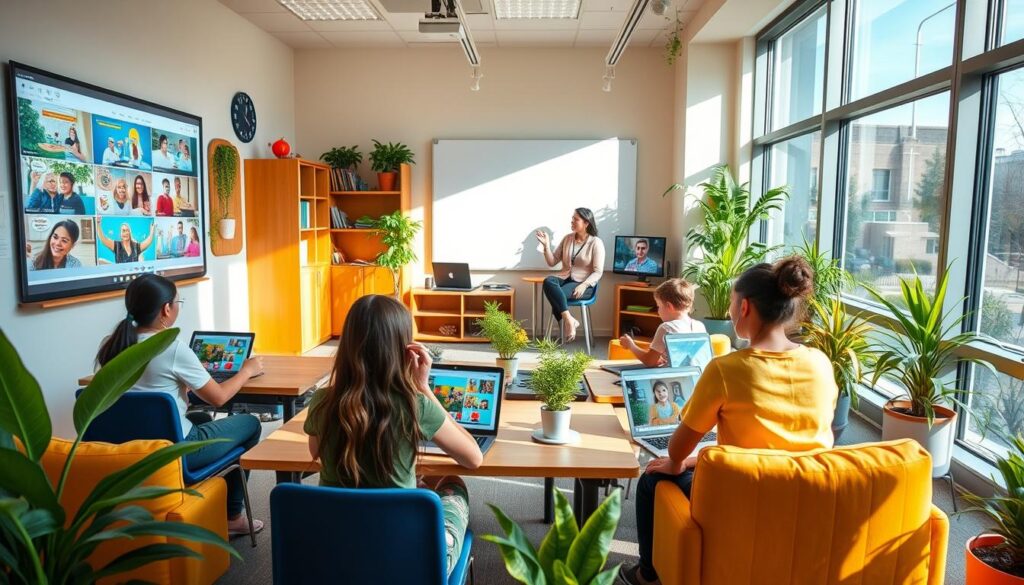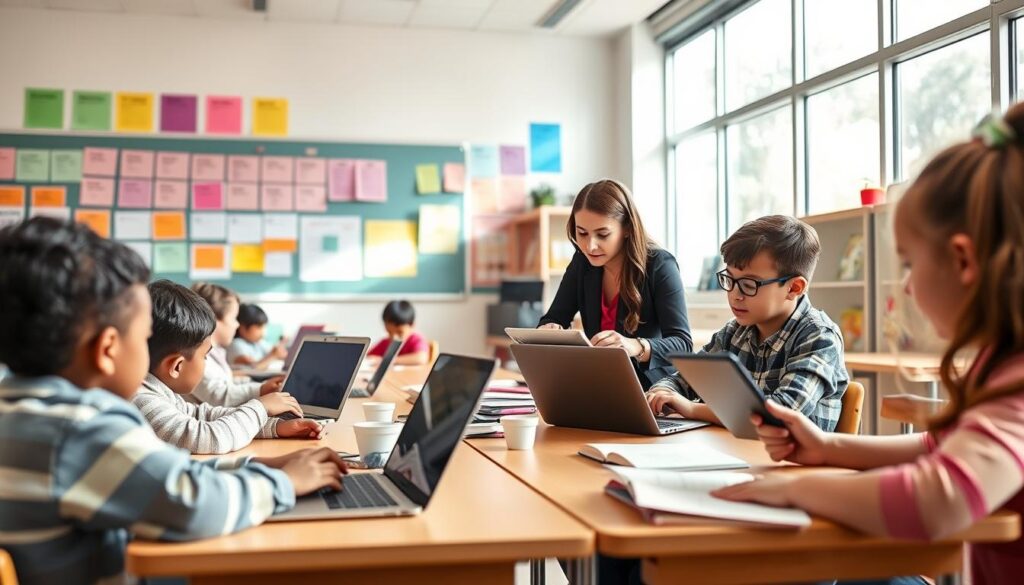Did you know that 98% of K-12 schools in the United States use blended learning? This method mixes online and in-person teaching. It has changed how students learn and succeed. Knowing about blended learning models and how to use them is key for teachers and schools today. (Blended Learning Models in Education)
This guide will explore blended learning’s main parts, its benefits, and the models used in schools. It’s for educators, administrators, or anyone interested in the future of learning. You’ll learn how to use blended learning to help students do their best.
Key Takeaways (Blended Learning Models in Education)
- Blended learning combines online and in-person instruction to create a more engaging and effective learning experience.
- The key components of blended learning include a flexible learning environment, personalized content, and increased student agency.
- Blended learning can improve student outcomes, increase flexibility, and enhance collaboration between teachers and students.
- Various blended learning models are being implemented in educational settings, each with its own advantages and considerations.
- Effective implementation of blended learning requires thoughtful planning, integration of technology, and a focus on student-centered learning.
What is Blended Learning?
Blended learning mixes online and in-person teaching. It uses digital tools and traditional methods for a better learning experience. Students get to control their learning pace and path.
Definition and Key Components
Blended learning blends digital and traditional teaching methods. It combines online and face-to-face learning. This way, students get the best of both worlds.
- Digital Content Integration: It uses interactive digital tools like videos and simulations to enhance classroom materials.
- Asynchronous and Synchronous Activities: It offers both online learning and live sessions to meet different learning styles.
- Personalized Learning Pathways: Students can control their learning pace and choose their learning path.
Benefits of Blended Learning Approaches
Blended learning has many benefits for students. Some key advantages are:
- Increased Student Engagement: Digital elements and interactive activities keep students interested and motivated.
- Personalized Learning Experiences: Students can learn at their own pace and focus on what they need most.
- Efficient Use of Instructional Time: It makes the most of classroom time by moving some activities online.
Blended learning combines online and in-person teaching for a more engaging and personalized learning environment.
Blended Learning Models in Education
Educators are now looking at different blended learning models to make learning better for students. These models mix traditional teaching with online and digital tools. This makes learning more personal and fun.
The flipped classroom is a popular choice. Students watch videos or do online lessons at home. Then, they use class time for hands-on activities. This way, students learn at their own pace and are ready to join in class discussions and projects.
Another model is the station rotation. Students move between different stations. They learn online, in small groups, and on their own. This lets students choose how they learn best.
The lab rotation model is great for subjects like science and engineering. Students switch between online learning and labs. Here, they use technology to explore and learn by doing.
Then there’s the individual rotation and enriched virtual models. In the individual rotation, students follow a set schedule of learning methods. The enriched virtual model mixes online learning with some face-to-face time.
Every blended learning model combines digital and traditional teaching. This creates a learning space that’s engaging, tailored to each student, and effective.

Implementing Blended Learning Effectively
Blended learning in schools needs careful thought about what the school and students need. When picking a blended learning model, look at what resources you have, what you want to achieve, and who your students are.
Choosing the Right Model
Not all blended learning models work the same way. Schools must look at their own needs and pick the best approach. This means thinking about things like:
- The level of technology integration required
- The desired balance between online and in-person instruction
- The learning preferences and needs of the student population
- The availability of instructional technology and support
By looking at these factors, schools can pick a blended learning model that works well for teachers and students.
Integrating Technology and Classroom Instruction
It’s key to blend technology and classroom teaching well for blended learning to work. This might mean giving teacher training to help them use technology easily. It also means making sure there’s good internet access and matching digital content with what’s taught in class. By doing this, schools can make learning better for everyone.

Conclusion (Blended Learning Models in Education)
This guide has shown the many benefits of blended learning in schools. It combines technology with traditional teaching to make learning more engaging and personalized. This approach helps students learn better and use their time wisely.
Teachers who pick the right blended learning model and use digital tools well can make learning exciting and prepare students for the future. This way, students get ready for the challenges of the 21st-century job market.
As technology gets better, blended learning in schools is set to grow even more. It has the power to change how we teach and learn. By using blended learning benefits, schools can offer learning experiences that meet the needs of today’s students.
Starting blended learning takes careful planning, but it’s worth it. It helps teachers find the right mix of technology and traditional teaching. This approach helps students work together, learn important skills, and get ready for the digital world. As education changes, blended learning will play a key role in shaping the future of blended learning.